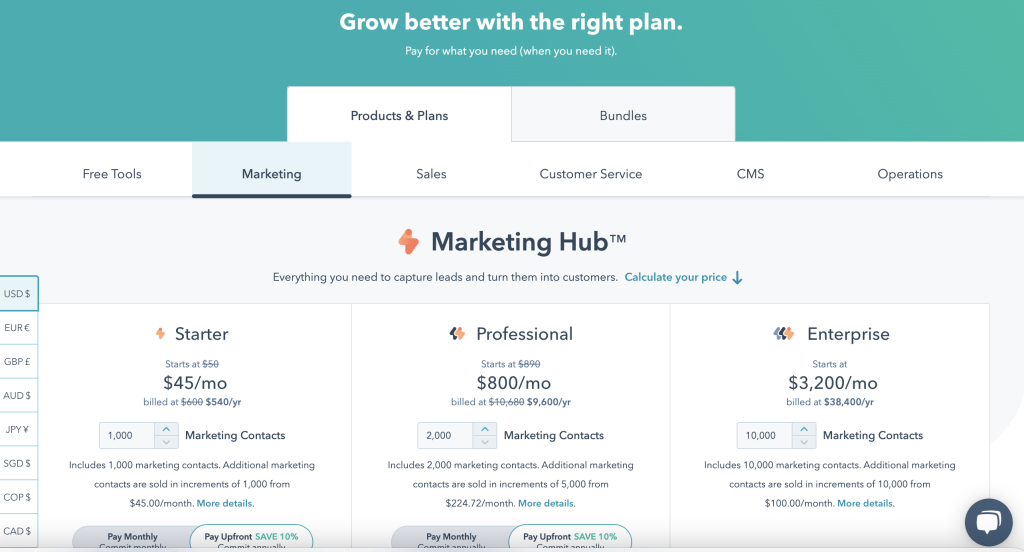What’s the ideal number of subscription tiers for a SaaS company?
Studies have found that three is the most common number, but is it the most optimal?
That’s not what we found when we studied the pricing plans of 50 best-in-class SaaS companies for our 2022 pricing pages report.
We studied the pricing pages of 50 companies that were among the top-rated in their market on G2 and found the number of monthly or annual plans offered varied from zero plans to 23.

From Zero to 23 Plans, Best-in-Class SaaS Companies Customize Their Subscription Options
And their packaging varied just as much.
“Keep it simple” is common advice for SaaS companies when it comes to pricing and plans, but the subscription offerings for most best-in-class companies are far from simple.
In this piece, we’ll look at how best-in-class SaaS companies promote and package their subscription plans, along with many tiered pricing examples.
Three Tiers Doesn’t Have to Mean Simple Plans
In the three-tier pricing strategy, we usually find:
- The cheapest option for small teams, individuals, or new customers trying out the product.
- The middle tier used for upsells. It’s often highlighted as the “most popular” or “most economical” option.
- The premium-priced plan for those needing more.
While this holds true for how best-in-class companies use a three-tiered pricing model, their packaging isn’t always that simple.
Pricing Changes Based on Number of Users
For instance, Canva uses three tiers but changes the pricing of the tiers based on the number of users.
Three Primary Plans as a Jumping Off Point
Airbase promotes three primary tiers, but their standalone bill payments option takes you to a different set of plans altogether. Effectively, prospects choose between value-based pricing or volume pricing. This is one way to allow potential customers to choose what they want to pay for.
We suspect that SaaS businesses may start with a simple three-tier approach, but their pricing and packaging, by necessity, grow more complicated as their users’ needs change.
Four Is the New Three (But Five Is Popular Too)
Per our research, the average number of plans is actually four. And there are a few common strategies for companies that maintain four or five pricing options.
Three Primary Plans Plus an Enterprise Plan

Why this works: You get to promote a middle plan, which gives the small and medium-sized customers (i.e., the non-enterprise customers) that sweet spot to shoot for.
Three Primary Plans and Two Enterprise Plans
Some companies like Box are graduating to five plans, including two enterprise tiers. Why shouldn’t enterprise folks have options too?

Free Plan Plus Three Paid Options
If you use a freemium model, then four different pricing points may make sense. Paid customers need room to grow into higher tiers.

Free Plan Plus Four Paid Options
Once again, adding a fifth option allows your customers more room to scale. But when adding more tiers, it needs to be extremely clear what you gain from moving to a higher price. In this case, TalentLMS is differentiating based on the number of users.

Rethink the Idea of a Plan
When we were analyzing pricing pages for the guide, it wasn’t always straightforward what should be considered a monthly or annual plan.
For instance, OneTrust Pro uses an a la carte approach to creating a monthly plan.
Similarly, Datadog offers a wide number of plans based on the many services they offer.

Instead of promoting tiers with set prices, Rippling only creates customized plans.

One sign it might be time to rethink a traditional tiered model is if you’re getting feedback from prospects or users that they’re paying for different features or functionality they don’t use. Another is if you have multiple products that your existing customer base are paying for separately.
Overall, we’re seeing best-in-class SaaS companies think outside the box when it comes to their packaging and pricing. And if you’re struggling to optimize your tiered pricing structure, it might be time for you to think outside the box as well.
Add Plans (and/or Pages) as You Target New Markets
A company like ButterCMS covers the market from startups to enterprise-level companies. Each primary persona has their own plan. If you’re selling to a new target market, make sure they’re represented on your pricing page before you make contact or start a marketing campaign.

Consider Different Pages or Tabs for Specific Markets
36% of the companies we studied utilize multiple pricing pages or tabs when they serve several markets or have separate plans for different products.
Tabs, like Mailchimp uses, make it easy to still see all pricing under one page — even though they’re promoting three unique products. The tabs offer clear differentiation between their products.

HubSpot takes this a step further with two levels of tabs: one for different products and plans, and one for bundles. Sometimes scaling doesn’t mean upgrading to the next tier. If you’re selling multiple products, is it time to bundle them together?

Below HubSpot’s premium pricing tiers and products, they also include another section dedicated to their free marketing tools.

How Else Are Best-in-Class Companies Explaining Their Plans?
Best-in-class companies may use very different pricing tiers, but we found several popular ways they explain how their pricing works.

Some of the most popular pricing page features include:
- An FAQ section (72%)
- Mentioning plan add-ons (42%)
- Highlighting the most popular plan (36%)
Check out our full report for more insights.
What Are You Looking for in a Subscription Management Solution?
This is where we come in. FastSpring’s full-stack payments solution includes flexible subscription management. We support free trials; monthly, annual, and customizable recurring billing; proration; discount management; and more. Check out our subscription management capabilities or sign up for free to try out our platform for yourself.
For more: Check out our in-depth guide to subscription billing platforms, including a comparison of five platforms.












